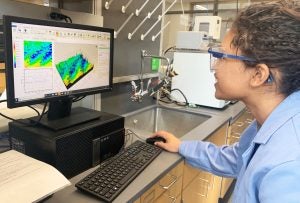
By Neil Nachbar
Vanessa Kamara has always had a curious mind and a thirst for knowledge.
As a biomedical engineering student at the University of Rhode Island, the junior has enjoyed learning about the many scientific disciplines involved in her major.
“Our biomedical engineering program is great because it integrates biology, chemistry, mechanics, and of course electronics,” said Kamara, who is from Brooklyn Park, Minnesota. “The issue for me is, I’m just too interested in everything.”
Getting Experience in the Lab
Seeking more hands-on experience to complement what she was learning in the classroom, Kamara volunteered in the spring of 2018 in Assistant Professor Kunal Mankodiya’s Wearable Biosensing Laboratory.
“Wanting hands-on circuitry skills, I knew I needed to get experience on a research project,” recalled Kamara.
Kamara first worked closely with graduate student Nick Constant and Mankodiya on wearable shoe insoles used for monitoring the gait of patients with Parkinson’s disease.
Having enjoyed her lab experience, Kamara took Mankodiya’s suggestion to work in his lab through a summer fellowship.
“The fellowship enabled me to fully immerse myself in multiple projects,” Kamara said. “I completed the course Linear Circuit Theory at the beginning of the summer while continuing to work with Nick. I was taught how to use an electroencephalogram (EEG), as well as the interface tools, to monitor the signals coming from people’s brains.”
One project Kamara worked on during the summer was a pressure sensing vest made to accompany a clinical trial. She gave a 10-minute presentation on the vest and its material characterization at URI’s Undergraduate Research Scholarly and Artistic Symposium.
“Vanessa is an eager-to-learn student who put a lot of effort into how to improve the design and capabilities of smart textile sensors,” Mankodiya said. “While working on our various projects, she quickly understood the needs and came back with a possible new design that could change the behavior of the sensor.”
Gaining Interest In Environmentally-Friendly Sensors
While Kamara learned a great deal about sensors and circuitry in Mankodiya’s lab, the discovery that resonated with her the most was an environmentally-friendly sensor.
“One of the articles I read was on Poly-L-Lactic Acid (PLLA) sensors,” Kamara said. “A sensor made entirely from biodegradable materials intrigued me.”
Polylactic Acid (PLA) is an all-purpose biodegradable polymer that has the strength and formability equivalent to petroleum resins (plastics).
“I worry about the environmental damage humans continue to do to the planet,” said Kamara. “It helps when people recycle, but the recycling process requires a lot of energy, which also hurts us.”
Enthusiasm Leads to First Funded Research
Taking everything she learned in her biomedical engineering courses and the Wearable Biosensing Lab, coupled with her passion for protecting the environment, Kamara decided to pursue an independent research project.
She submitted a proposal titled “Poly-L-Lactic Acid Sensor Characterization via Fabrication Technique” to the URI Office of Undergraduate Research & Innovation, which agreed to fund her research.
“The goal of the project is to fabricate nano strands from lactic acid,” explained Kamara. “We can then take those strands and lay them on a piece of clothing or another substrate in such a way to create a sensor. Due to our methods of fabrication, we can orient the charged portions of the molecules so that the sensor will power itself.
“We can then connect this sensor to hardware to monitor the voltage output,” Kamara continued. “The fact that it can be utilized as a generator for itself, and possibly other creations, along with it being biodegradable, reduces the overall carbon footprint caused by many electronic devices that utilize plastic.”
While Kamara envisioned the sensor being used in wearable technology, she also considered another important possibility.
“It could potentially be used inside of humans for various medical applications, such as a stent in the heart, coating for medicinal uses, or even a nano-generator,” stated Kamara.
An Interdisciplinary Approach Leads to Success
Due to the chemical makeup of the sensors and the equipment that would be needed to conduct her experiments, Kamara approached Prof. William Euler in URI’s Department of Chemistry about working in his laboratory.
“After speaking with Dr. Euler about the goal of my project and working through some chemical questions I had, we solidified a plan for the sensors,” Kamara said. “The nice part about working with this lab is that there will always be someone else present who can assist me if any issues come up.”
One of the pieces of equipment Kamara will need for her research is a scanning electron microscope, to accurately measure the width of the strands of fiber.
“The size of the fiber determines the amount of force we can apply on the sensor and how much electricity it will output,” explained Kamara.
Kamara is better prepared to work in a chemistry lab than most non-chemistry majors would be, having taken courses in organic chemistry and biochemistry. She’s also learned a lot about the subject from her two roommates, who are chemical engineering students.
“I’ve had an interest in chemistry for a long while, but don’t have room in my schedule to take many electives,” Kamara said. “Thankfully, my roommates have helped me understand some concepts and have shared their course notes with me.”
Kamara is well aware of how valuable this independent research project will be to her future.
“The skills I’ll gain from this project, along with the research articles I hope to get published based on my results, will go a long way toward building my resume for graduate school,” said Kamara. “Seeing the more biochemical side of biomedical engineering could also help me decide what I truly would like to pursue for my career.”
